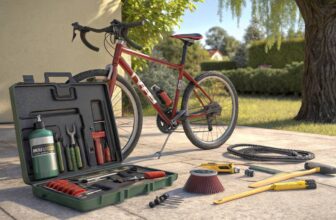Grasping Hybrid Bike Weight
How much a hybrid bike weighs? It’s a mix of elements like suspension and gear count that tip the scales. Knowing these bits and bobs helps bikers choose wisely – achieving a setup that suits their particular pedaling antics.
What Suspension Brings to the Table
Suspension is a bit of a heavyweight in the bike world. It plays a part in how much a hybrid bike weighs. Lots of hybrid bikes skip suspension to remain light and nimble, perfect for daily scooting around town or smooth strolls on paved roads. As REI points out, those bouncy suspension forks can pile on the pounds and even slow you down. So, if a rider’s game is centered around light weight and cruising smooth routes, going sans suspension is usually the ace choice.
| Hybrid Bike Type | Suspension | Weight Thoughts |
|---|---|---|
| No Suspension | Nope | Lighter, quicker go |
| Front Suspension | Forked | Chubbier, better for bumps |
Eyeing a bike for downtown dashing? Peek at our tips on hybrid bike commuting.
Gearing Up or Down: The Gear Dilemma
Gears? They bring their own weighty tale to the bike. Bikes with fewer gears usually come lighter, favored by those who live and die by the lightweight credo. You even find hybrids with a single speed for power-packed riders or folks spinning on flat land. REI rightly states that trimming gear numbers can pare down bike bulk considerably.
Conversely, a spread of gears, typically with three chainrings up front, meets a whole load of terrain with ease. But more gears equal more weight. Cal Coast Adventures suggests thinking about this gear weight balancing act against how the bike will be ridden.
| Gear Layout | Ideal Use | Weight Thoughts |
|---|---|---|
| Single Speed | Flat Surfaces | Light as a feather |
| Multiple Gears | Mixed Terrains | Adds extra pounds |
Want to nerd out on gearing and how it messes around with the ride? Check out our write-up on hybrid bike gears.
Balancing these thoughts, city slickers, weekend warriors, and gym junkies can nail down the perfect hybrid bike fit, juggling weight with needed features. For the real nitty-gritty on bike parts and their effects, pop over to our page about hybrid bike components.
Materials and Weight
Picking out your perfect hybrid ride isn’t just about the cool paint job; it’s about knowing what’s under the hood—er, frame. The big three in bike materials are aluminum, steel, and carbon fiber, each offering its own perks and quirks, especially when it comes to weight.
Aluminum, Steel, and Carbon Fiber
Aluminum
Aluminum’s like that friendly neighbor—reliable, not too fancy, but always up for a good ride. It’s lightweight and won’t bust your budget, perfect for folks pedaling around town or cruising casually. This metal’s tough against rust, a major bonus for those biking rain or shine.
Steel
Steel brings that old-school vibe, heavier than aluminum but giving you a velvety ride thanks to its flexibility and shock soaking skills. Tough as nails, steel bikes laugh in the face of bumps and rough patches, making them fantastic for those long, comfy-day rides or multi-surface adventures.
Carbon Fiber
Think of carbon fiber as the rockstar of bike materials. Super light, it’s all about speed and high performance. It offers a smooth ride, soaking up those pesky vibrations. While it’s on the pricier side and may not last through quite as many tumbles, its featherlight nature is perfect for speed demons and fitness enthusiasts.
Material Breakdown:
| Material | Weight | Durability | Cost | Comfort Factor |
|---|---|---|---|---|
| Aluminum | Light | High | Budget-friendly | Moderate |
| Steel | Heavier | Very High | Mid-range | High |
| Carbon Fiber | Super Light | Moderate | High | Top-notch |
Weighing Your Options
When it comes to how your bike feels, lighter isn’t always better—but sometimes it is. Your bike’s weight influences how zippy and comfy your ride will be.
Aluminum: Light and nimble, perfect for city slickers. Ideal for folks with no garage space, since they’re easy to stash in little nooks and crannies. Learn more about commuting with hybrid bikes or sneaky bike storage.
Steel: Tough cookies who want comfort and can take a knock or two will appreciate steel. Perfect for off-road adventures or extended journeys. Peek into our guides on touring and multi-surface routes.
Carbon Fiber: For those who make like the wind, carbon fiber is hard to beat, especially if you thrive on performance. Its light-as-a-feather feel helps you sweat less and enjoy more. See why it’s a favorite among fitness newbies.
Keep in mind that the frame’s material isn’t the sole decider; other bits like tires, gears, suspension, and handlebars all play their parts. Knowing what materials bring to the table will help you align your bike’s personality with your riding style. For deeper scoops on frame impact on ease and speed, check out our articles on bike frames and geometry.
By juggling these ideas, you’ll be on a bike that’s not only your style but fits your lifestyle to a T, whether you’re city cruising or chasing the sunset on the trails.
How Components Affect Hybrid Bike Weight
When diving into what makes a hybrid bike bulkier or lighter, the parts that stand out most include things like fenders and wheel size. These not only impact how much the bike weighs but also how it gets the job done.
Do Fenders Weigh You Down?
Fenders are a commuter’s best friend, shielding you from mud splashes and puddles (shoutout to REI for backing this up). However, they also add some heft to your ride.
| Good Stuff | What It Means for Weight |
|---|---|
| Keeps you clean | Adds to weight |
| Protects your clothes | Heftier bike |
| Great in the rain | Not needed if it’s sunny |
If it’s sunny and dry, skipping the fenders can make your bike lighter and speedier. This info is gold for those who want a featherweight ride. If you’re curious about pimping out your ride more, take a look at hybrid bike accessories.
Wheel Size: How It Tips the Scales
Hybrid bikes roll on either big 700c wheels or smaller 26-inch ones. This choice changes both the bike’s weight and how it feels to ride (again, thanks REI).
| Wheel Size | Weight Impact | How It Feels to Ride |
|---|---|---|
| 700c | Average weight | Smooth sailing on city streets |
| 26-inch | Lighter | Agile and great for mixed terrains |
Most folks grab 700c wheels for city cruising and smooth sailing because they’re efficient and comfy. Meanwhile, the light 26-inch wheels are pretty nifty for riders who like a bike that’s nimble and good on different types of paths.
Getting to grips with these differences helps you choose the perfect hybrid bike for your rides. For a deeper dive into wheels, peek at our guide on hybrid bike wheel size.
By weighing up fenders and wheel size, you can walk away with a ride that has the right mix of features while staying light, which can make your rides way more fun. For more tips on boosting your bike’s performance, check out hybrid bike upgrades.
Comparing Road and Hybrid Bikes
Frame Weight and Material
Alright, let’s break it down: when it comes to frame weight and what they’re made of, road bikes and hybrids are not just one-size-fits-all. Most folks cruising city streets on a hybrid bike are pedaling something built from aluminum. It’s kind of the MVP for being light on the wallet and the scales. But don’t count out steel and carbon fiber – they’re in the mix too.
| Material | Road Bikes | Hybrid Bikes |
|---|---|---|
| Aluminum | Common | Very Common |
| Steel | Less Common | Common |
| Carbon Fiber | Very Common | Less Common |
Now, why’s that matter? Well, it’s like this: road bikes are all about the “fast and the furious” lifestyle—think carbon fiber, meant to cut the weight and max the agility. You want speed, you got it, but your comfort might take a bit of a backseat. Meanwhile, hybrid bikes are about cruising, comfort, and taking the scenic route without the racecar vibes, hence they often opt for a hearty aluminum or steel (Cal Coast Adventures).
The weight difference between aluminum and carbon? We’re talking maybe a pound, but sometimes that’s the difference between breezing up a hill or puffing like an old-timey steam engine. Choice of materials? Totally up to how you plan to ride.
Speed Variations for Weight
Speed – the thrill of the chase or a leisurely stroll through the park? This is where road bikes and hybrids wave their respective flags. With road bikes, you’re looking at precision parts and a frame that’s aggressively on a diet. They’re lean, mean, and all about shaving those precious pounds with minimal gear. Two chainrings up front keep things straightforward and fast. Hybrids, the Jack-of-all-trades here, strap on a third chainring giving you gearhead cred for climbing or cruisin’ (Cal Coast Adventures).
| Bike Type | Chainrings | Average Speed (mph) |
|---|---|---|
| Road Bikes | 2 | 15-20 |
| Hybrid Bikes | 3 | 10-15 |
Now, road bikes? They’re into aero-dynamic living. You lean in like you’re channeling your inner Lance Armstrong. Drop handlebars give you even more ways to embrace that speed demon life (Cal Coast Adventures). But if a back-friendly ride is more your vibe, hybrid bikes think of you with flat bars, treating you to a more upright cruise—not the wind tunnel, but infinitely comfier.
So, in summary, road bikes scream “fast and furious,” while hybrids are your best buddies for varied adventures and comfort lovers out there. Looking for more geeky details or planning your next city commute? Dive into our thoughts on hybrid bike geometry and hybrid bike commuting.
Component Differences
Components of Hybrid Bikes
Hybrid bikes strut their stuff with a blend of features that make them city slickers but just as comfortable in the great outdoors. Whether you’re cruising through town, breaking a light sweat, or exploring mixed terrain, hybrids got your back with their comfy and handy setup. According to Cal Coast Adventures, hybrids come in second place to road bikes in the component department, but that doesn’t mean they don’t pack a punch where it counts.
Here’s the lowdown on what you’ll usually find on hybrid bikes:
- Drivetrain: Got gears galore. Hybrids often flaunt three chainrings upfront, ready to tackle your love for both pancake-flat streets or steep hills.
- Brakes: Keeping you safe, hybrids come with rim brakes or disc brakes. Rim brakes are the rookie’s friend, but disc brakes play the hero with excellent stopping power, especially if you’re navigating sketchy paths.
- Handlebars: Expect to see flat or a bit lifted handlebars—keeping your ride comfy and your back thanking you later (hybrid bike handlebars).
- Wheels and Tires: Balancing speed with staying stuck to the road, hybrids sport medium-width tires which resist the dreaded punctures, perfect for city hustling (hybrid bike tires).
- Suspension: Some models come kitted with front suspension forks to cushion those bumpy rides (hybrid bike suspension).
- Additional Features: Equipped with mounts for fenders, racks, and lights, hybrids are built for practicality and daily adventures (hybrid bike fenders, hybrid bike racks).
Components on Road Bikes
Road bikes are the drag racers of bicycles, designed to speed like a dream. As tipped off by Cal Coast Adventures, road bikes come outfitted with top-shelf components compared to their hybrid counterparts.
Here’s what swoon-worthy features you’ll find on road bikes:
- Drivetrain: They zero in on speed with a narrower gear range. These bikes usually have two chainrings, chopping down on weight while keeping performance sky-high.
- Brakes: Road bikes often showcase either rim brakes or hydraulic disc brakes—the latter is the boss when it comes to precision stopping, no matter the forecast.
- Handlebars: Drop handlebars let you switch up hand positions, putting you in the prime aerodynamic form to dodge the wind like a pro (hybrid vs road bike).
- Wheels and Tires: Thin as can be, these tires zip along with less effort, amping up speed. The wheels themselves are lightweight but durable, featuring more profound rims to cut through the air.
- Frame: Lightness and agility are the game here, with frames made from featherweight stuff like aluminum, carbon, or even titanium (hybrid bike frames).
- Additional Features: Shedding extra pounds and drag, road bikes spare themselves from extras, nixing fender and rack mounts.
| Component | Hybrid Bikes | Road Bikes |
|---|---|---|
| Drivetrain | Wide gear range, 3 front chainrings | Narrow gear range, 2 front chainrings |
| Brakes | Rim or disc brakes | Rim or hydraulic disc brakes |
| Handlebars | Flat or slightly raised | Drop handlebars |
| Wheels and Tires | Medium-width, puncture-resistant tires | Thin, low rolling resistance tires |
| Frame Material | Aluminum, steel, carbon | Aluminum, carbon fiber, titanium |
| Additional Features | Mounts for fenders, racks, lights | Minimalist for weight and speed |
Choosing between a hybrid or road bike? The nitty-gritty of their parts might just make your decision for you. For more tricks of the trade on hybrid bike bits and bobs, pop over to hybrid bike components, and for keeping it in top shape, give hybrid bike maintenance a look.
Weight Distribution and Riding Comfort
Getting the hang of how weight spreads out on different types of bikes is key for a comfy ride. This bit digs into how the weight shifts on road bikes versus hybrid bikes, affecting comfort and how well they roll.
Rider Weight Distribution on Road Bikes
On a road bike, how it’s built helps spread the rider’s weight pretty evenly over the main spots you touch the bike. The bike’s shape tends to stretch the rider out, putting a bunch of weight on the handlebars, seat, and pedals. This setup’s really about going fast and slicing through the air (Cal Coast Adventures).
Road bikes also have those drop bars, offering where you put your hands into different spots. This helps spread the weight across the upper body, easing up on your back and upping the comfort level for longer journeys.
Rider Weight Distribution on Hybrid Bikes
Hybrid bikes, though, let you sit more upright. This design puts more of your weight on the seat, making these bikes a top pick for folks who just wanna chill and city riders. It might not be the fastest setup, but it’s definitely comfier for laid-back rides (Cal Coast Adventures).
With flat handlebars, hybrids limit hand positions but stick to comfort and easy handling, making them the go-to for mixed surfaces and urban riders(city dwellers).
| Feature | Road Bikes | Hybrid Bikes |
|---|---|---|
| Riding Position | Stretched out | Upright |
| Weight Distribution | Seat, handlebars, pedals | Primarily seat |
| Handlebar Type | Drop bars with multiple hand positions | Flat bars with single hand position |
| Comfort Level | Less comfy, more aerodynamic | Super comfy, less aerodynamic |
Knowing these differences tailors the bike to what the rider needs. Hybrids blend comfort and practicality, while road bikes suit those aiming for speed and sleekness. For more insights on hybrid bike gears and hybrid bike tires, check out our detailed guides.
Aerodynamics and Weight
Getting a handle on how air dynamics and weight play into biking can help anyone who wants a smoother, faster ride or just a more comfy one. Let’s take a peek at what makes road bikes cut through air like a knife and how just the right amount of weight plays into hybrid models.
Aerodynamic Features of Road Bikes
Road bikes are built to slice through the air, leaving other bikes in the dust. Here’s what makes them tick:
- Rider Position: On a road bike, you’re practically hovering over the handlebars. Lowering your back this way helps cut down on that pesky wind making you work harder.
- Handlebar Style: Those drop bars let riders choose from three different grips, each more bendy and front-leaning than the last (Cal Coast Adventures).
- Frame Shape: The bike’s frame has thin tubes designed to zip through the air.
- Lightweight: A top-notch road bike’s weight hangs around 15-17 pounds (6.8-7.7 kg). But you’ll find plenty in that 18-20 pound (8.1-10 kg) club. Pros are limited by that magical 6.8 kg (just shy of 15 pounds) rule (The Pro’s Closet).
| Feature | Road Bike |
|---|---|
| Rider Position | Lower, forward lean |
| Handlebar Type | Drop bars |
| Frame Geometry | Streamlined, narrow |
| Average Weight | 15-17 lbs (6.8-7.7 kg) |
Aerodynamic Considerations for Weight
Hybrids? They’re more about cruisin’ than racin’. But a few tweaks can help them cut some wind too:
- Rider Position: You’re sitting nice and tall on a hybrid. Sure, there’s more wind smackin’ your face, but it’s comfy if you’re just pedaling to work or chilling on the weekend.
- Bars: Flat bars keep your ride comfily upright and there’s less hassle moving around (Cal Coast Adventures).
- Frame and Parts: It ain’t as slick as a road bike, but a hybrid frame’s smart use of aluminum or carbon fiber keeps it from turning into a clunker.
| Feature | Hybrid Bike |
|---|---|
| Rider Position | Upright, comfortable |
| Handlebar Type | Flat bars |
| Frame and Component Weight | Moderate |
Knowing these tidbits helps in picking the right bike for your life and style. For a side-by-side of hybrid vs road bikes, take a look.
While checking out hybrid bike weight, keep in mind hybrids can’t quite match road bikes for slice-through-the-air moves. But they make up for it with durability and comfort, making them solid choices for urban riders, comfort lovers, or anyone making the jump from car to bike.
For more handy hints on how to make sure your hybrid is just right for you, including weight tips, drop in on our pages about hybrid maintenance and bike upgrades.
Weighing In: Bike Weight Ranges
Shopping for a hybrid bike and trying to figure out how it stacks up against others in the weight department? You’ve landed in the right place. Let’s chat about road bikes first, then roll into gravel and mountain bikes, going over what makes each unique in the weight game.
Average Weights of Road Bikes
Road bikes are all about being light as a feather and fast. They’re your go-to for shaving seconds off your time. Those fancy road racers typically clock in at a featherweight of 15-17 pounds (that’s around 6.8-7.7 kg for those of you metric fans). Mid-range ones hang in there at 18-20 pounds (8.1-10 kg). Oh, and if you’re on the pro tour, the UCI won’t let you go lighter than 6.8 kg. Can’t have folks flying away, now can we?
| Road Bike Type | Weight (lbs) | Weight (kg) |
|---|---|---|
| High-end Road Bikes | 15-17 | 6.8-7.7 |
| Mid-range Road Bikes | 18-20 | 8.1-10 |
| UCI Minimum | 14.99 | 6.8 |
For a full-on showdown between hybrids and roadies, check out our comparison here.
Weight Ranges of Gravel and Mountain Bikes
Gravel and mountain bikes – the beefier cousins in the bike world. Gravel bikes meant to tackle all sorts of off-road adventures, pack more heft. Top-of-the-line ones weigh about 18-20 pounds (8.1-9 kg), while the budget-friendly options are around 22-26 pounds (10-11.8 kg).
| Gravel Bike Type | Weight (lbs) | Weight (kg) |
|---|---|---|
| High-end Gravel Bikes | 18-20 | 8.1-9 |
| Budget Gravel Bikes | 22-26 | 10-11.8 |
Mountain bikes laugh in the face of rough trails with their tough frames and hefty tires, hitting scales at 25-30 pounds (11.3-13.6 kg).
| Mountain Bike Type | Weight (lbs) | Weight (kg) |
|---|---|---|
| Mountain Bikes | 25-30 | 11.3-13.6 |
For more on bike tech and the nitty-gritty of components and weights, wander over to our guides on hybrid bike suspension and hybrid bike components.
Getting the weight lowdown helps you pick a bike that’s just your speed and style. Thinking of swapping your ride for something hybrid? We’ve laid out the latest on hybrid bike gears, frames, and all those snazzy upgrades just waiting to be explored.
Enhancing Performance Through Weight
Dialing in the weight of your hybrid bike can really kick things up a notch, making your ride smoother and more efficient. Here we’ll chat about why lighter wheels and tires are a game-changer and how bike weight can make climbing a breeze.
Importance of Lighter Wheels and Tires
Those light wheels and tires? They’re not just for show; they’re a big deal for hybrid bikes. Since they make up the rotating weight, they shape how the bike handles and zips along. Lighter wheels mean a bike feels snappier and easier to steer. The folks over at The Pro’s Closet reckon lighter wheels are a top-notch upgrade for shaving weight off both road and mountain bikes.
Take carbon fiber wheels: they’re a favorite thanks to their mix of strength and lightweight magic. They weigh less than the old-school aluminum ones, giving you better pickup and a boost in overall ride fun. Perfect for city riders and those who like to tackle a mix of paths with ease and speed.
| Wheel Material | Average Weight (kg) |
|---|---|
| Aluminum | 1.5 – 2.0 |
| Carbon Fiber | 1.2 – 1.5 |
For a deeper dive into wheels and the knitty-gritty of bike pieces, head over to our hybrid bike components section.
Impact of Bike Weight on Climbing
Your bike’s weight is your secret weapon when it comes to climbing—it directly jives with the power-to-weight balance. A lighter bike needs less oomph to scale hills, giving you a real lift in efficiency. As The Pro’s Closet points out, using less power means you can save your strength and keep your stamina up on those long, tough climbs.
Sure, bike weight matters, but don’t forget about the rider’s weight—typically way more than the bike itself. So getting that sweet power-to-weight spot means trimming some bike weight and maybe shedding a little bit yourself. That well-rounded method guarantees efficient climbing and a smoother ride for fitness newbies and active seniors who want to get the most out of their hybrid bike adventure.
For more on how weight switches up your climbing game and other ride angles, swing by our hybrid bike climbing and hybrid bike fitness guides.
By zooming in on these weighty matters, you can seriously amp up your hybrid bike’s performance, making each ride more fun and efficient. Whether you’re cruising city boulevards or exploring verdant trails, getting the weight right makes all the difference.




